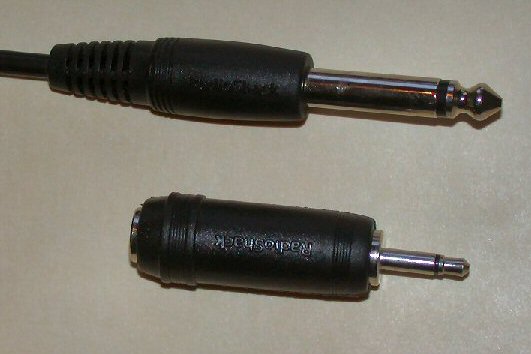On the acoustic guitar forums I visit, one common question goes something like:
How do I record my guitar so I can judge my progress (or lay down a rhythm track or even make a CD just for family and friends). I have a pickup in the guitar, I don’t need great quality, and I don’t want to spend a lot.
Since this person is posting on an internet forum, I will assume they have a computer. If it’s a PC type, it almost certainly has some kind of built-in soundcard, with at least a mic input. So all we need to do is hook the guitar pickup to that mic input and use some sort of program to capture that input and save it to a file. It just so happens that there are some very effective recording programs available to download for free, so that leaves as our only problem some way to connect the guitar pickup to the mic input. And here it is:

This is a 1/4″ phone female to 1/8″ mini male adapter. A normal guitar cable like the one just above the adapter in this picture (male 1/4″ phone plugs at both ends) fits into the hollow side. The pointed side plugs into the mic input of the computer. It costs about $4.00 at any store or web site that sells electronic geegaws (like Radio Shack). This is all you need to connect your pickup to your computer (assuming you have a guitar cable).
Now, on the software side what are the options? Unfortunately, the built-in Windows Sound Recorder is not very useful. It’s limited to about 1 minute of continuous recording without intervention. There are not effects or editing features, no click track or metronome, no metering, and certainly no multitrack overdubbing and mixing.
The easiest free program I’ve found is Audacity – it’s a little clunky but it is full featured. It includes plenty of editing capability and built-in effects, and you can save your recordings to various formats like .wav for burning to CD and (with some free extra software) to .mp3 for your portable music player or web site. I’ve used this little adapter and Audacity to record new song ideas on our laptop when we’re traveling. I’ve also used it to create practice loops when I’m trying to nail a tough section of a new song. Compared to a decent microphone, preamp, and audio interface these recordings are fuzzy, noisy, and crude, but they do the job, and the price is definitely right.
Here’s one verse of an old Hawaiian song, “No Ke Ano Ahiahi,” recorded as a solo guitar instrumental using the the 1/8″ mini plug adapter and Audacity.
And here’s the same track with some reverb added.
Obviously these are not “major label quality” recordings by a long shot. The direct output from a pickup is not very close to the natural acoustic sound of your guitar. But we’ve looked at a tool that can help get your pickup based recordings much closer to a natural acoustic sound in a previous blog entry: “Better EQ Through Software”. And, as we stated at the beginning of this entry, the whole purpose of using this simple, cheap adapter is to get simple, cheap recordings, not Grammy awards.